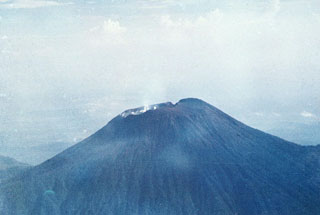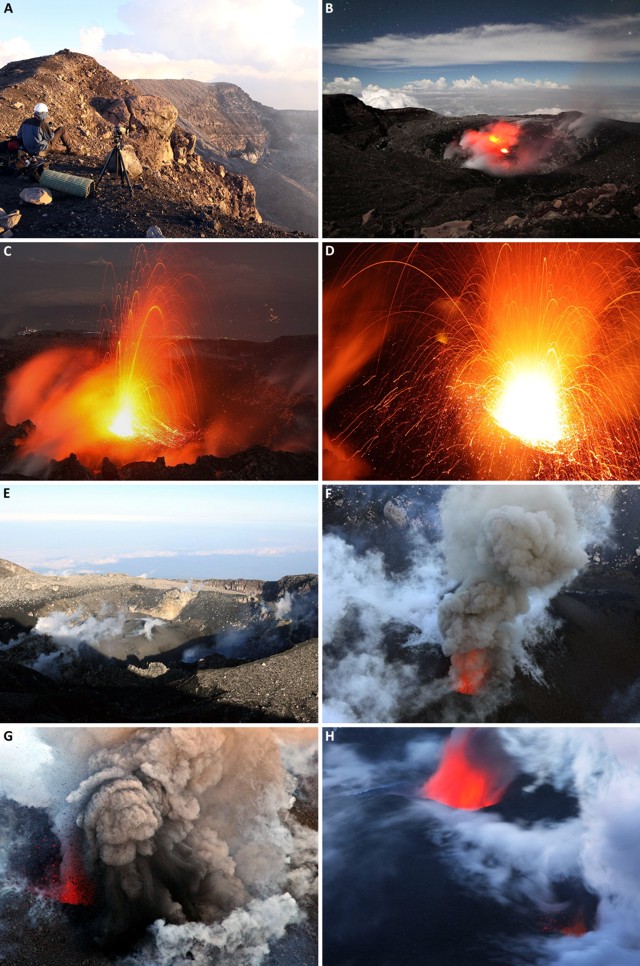Report on Slamet (Indonesia) — January 2010
Bulletin of the Global Volcanism Network, vol. 35, no. 1 (January 2010)
Managing Editor: Richard Wunderman.
Slamet (Indonesia) Explosions send tephra ~700 m above summit through at least June 2009
Please cite this report as:
Global Volcanism Program, 2010. Report on Slamet (Indonesia) (Wunderman, R., ed.). Bulletin of the Global Volcanism Network, 35:1. Smithsonian Institution. https://doi.org/10.5479/si.GVP.BGVN201001-263180
Slamet
Indonesia
7.242°S, 109.208°E; summit elev. 3428 m
All times are local (unless otherwise noted)
Minor explosions at Slamet with occasional lava fountains and small ash plumes occurred from April through early June 2009 (BGVN 34:05). During the rest of June 2009, this activity continued. The Center of Volcanology and Geological Hazard Mitigation (CVGHM) reported that during 8-28 June, tephra was ejected 50-700 m above the crater. In addition, incandescent material was ejected 50-300 m above the crater. Booming noises were also reported. During 23-29 June, incandescence and ash emissions were not observed. On 29 June, CVGHM lowered the Alert Level for Slamet to 2 (on a scale of 1-4) because of decreased seismicity and emissions.
Based on pilot observations, the Darwin Volcanic Ash Advisory Centre (VAAC) reported that on 8 August and 12 September 2009 ash plumes rose above the summit. In neither case was ash identified on satellite imagery.
June 2009 observations at the summit. Thorsten Boeckel and Martin Rietze climbed Slamet on 13 June 2009 and spent a night at the summit and at their camp at 3,200 m (figure 3). They said that reports issued prior to their climb noted plumes up to 700 m above the summit, but the activity later decreased to a point where the risk of being struck by a volcanic bomb had diminished, though hard hats were worn. These photographers have considerable experience on active volcanoes. Besides Strombolian eruptions, gas-fed flames sometimes reached ~ 20 m high (figure 3).
Approaching the summit they observed the vent to assess the risk and ultimately felt secure in advancing to more exposed positions on the rim. Deafening noise came from the two vents in the middle of the ~ 100-m wide intra-crater cinder cone. Figure 3 (B and E) present overviews of the active crater area. Two vents were glowing.
Initially, each eruption had a similar character, starting with a emission of gas and flames with a slightly blue-green color rising ~ 5 m above the vent. These emissions and flames later grew to reach ~ 20 m above the vent. As the eruptions proceeded the emissions became increasingly red. Eventually there was an explosion and lava fountains jetted up to ~ 200 m above the vent. Occasionally a second vent glowed (figure 3, B and D, and due to flames in H).
Fog at the crater made photography difficult at times. Strong luminosity from the gas flames would sometimes overexpose a portion of the photo. As dawn approached, more forceful tephra emissions generated billowing ash clouds (figure 3, F and G). Next, the loudest detonation of their stay occurred, but explosions did not become more violent over the next 6 hours.
Boeckel and Rietze had observed flames here in 2006. Rietze, who has visited more than 24 volcanoes, said he had never seen such impressive flames as those at Slamet: "These flames [during the 2009 visit (figure 3 H)] were up to 10-20 m high...shining intensely even without ejecta. In fact this was the reason why all long exposure images were burnt out in the center, it was not possible to photograph the Strombolian phases as with other volcanoes due to this. Of [course, the flames] changed from time to time, sometimes there were flames only, and sometimes only Strombolian phases."
Boeckel and Rietze also presented videos of vigorous flames on their websites. The cause of the flames remains uncertain in the absence of instrumental (eg., spectrometer) data. Occasional reports of combustion and flames are known at volcanoes, for example, from combustion of methane, or hydrogen (the latter, discussed by Naughton, 1973), and flames of various colors were documented in the 1943-1951 eruptions at Parícutin (Luhr and Simkin, 1993). In addition, the eruption of Tolbachik in July 1975 generated flames (Fedotov, 1984), and blue flames were associated with active vents preceding the 18 May 1980 eruption at St. Helens (SEAN 05:03).
During Rietze and Boeckel's 2006 visit, the active intracrater cone contained pits in both the middle and flank areas, with hundreds of small deep-orange flames (up to 2 m high) constantly burning. By 2009 the pits had filled up with debris, but new vents atop this area emitted burning gas and bursts of lava.
References. Fedotov, S.A. (ed.), 1984, The Great Fissure Tolbachik eruption, Kamchatka 1975-1976: Nauka, Moscow, Academy of Sciences of the USSR Far East Science Center, Institute of Volcanology, 637 p. (in Russian).
Luhr, J., and Simkin, T., 1993, Parícutin: The volcano born in a Mexican cornfield: Geoscience Press, Phoenix, Arizona, USA. 427 p.
Naughton, J.J., 1973, Volcanic flame: source of fuel and relation to volcanic gas-lava equilibrium: Geochimica et Cosmochimica Acta (Elsevier Ltd.), v. 37, no. 5, May 1973, p. 1163-1169, doi:10.1016/0016-7037(73)90053-7
Geological Summary. Slamet is one of Java's most active volcanoes. It has a cluster of about three dozen cinder cones on its lower SE-NE flanks and a single cinder cone on the W flank. It is composed of two overlapping edifices, an older basaltic andesite to andesitic volcano on the west and a younger basaltic to basaltic andesite one on the east. Gunung Malang II cinder cone on the upper E flank on the younger edifice fed a lava flow that extends 6 km E. Four craters occur at the summit of Gunung Slamet, with activity migrating to the SW over time. Eruptions recorded since the 18th century have originated from a 150-m-deep, 450-m-wide, steep-walled crater at the western part of the summit and have consisted of explosive eruptions generally lasting a few days to a few weeks.
Information Contacts: Center of Volcanology and Geological Hazard Mitigation (CVGHM), Jalan Diponegoro 57, Bandung 40122, Indonesia (URL: http://vsi.esdm.go.id/); Darwin Volcanic Ash Advisory Centre (VAAC), Bureau of Meteorology, Northern Territory Regional Office, PO Box 40050, Casuarina, NT 0811, Australia (URL: http://www.bom.gov.au/info/vaac/); Thorsten Boeckel (URL: http://www.tboeckel.de/); Martin Rietze (URL: http://mrietze.com/i-Slamet09.htm).


